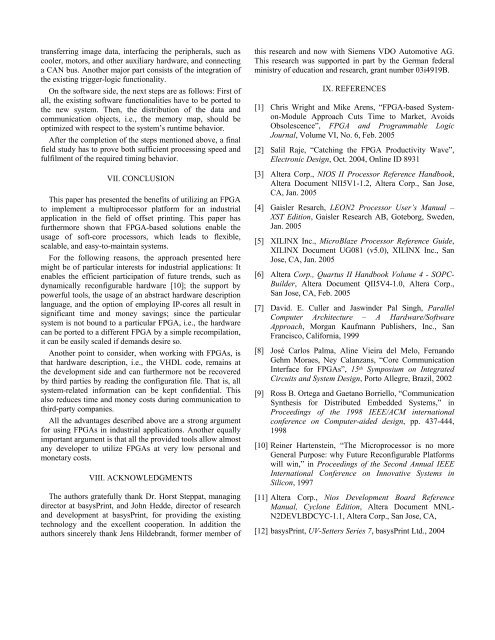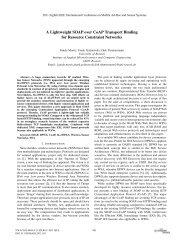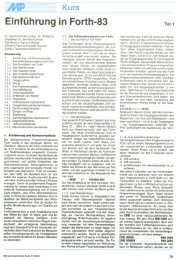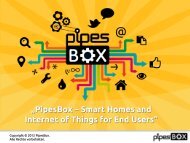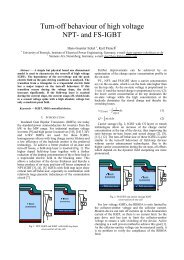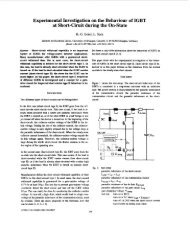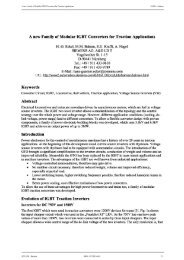Advantages of FPGA-Based Multiprocessor Systems in Industrial ...
Advantages of FPGA-Based Multiprocessor Systems in Industrial ...
Advantages of FPGA-Based Multiprocessor Systems in Industrial ...
You also want an ePaper? Increase the reach of your titles
YUMPU automatically turns print PDFs into web optimized ePapers that Google loves.
transferr<strong>in</strong>g image data, <strong>in</strong>terfac<strong>in</strong>g the peripherals, such ascooler, motors, and other auxiliary hardware, and connect<strong>in</strong>ga CAN bus. Another major part consists <strong>of</strong> the <strong>in</strong>tegration <strong>of</strong>the exist<strong>in</strong>g trigger-logic functionality.On the s<strong>of</strong>tware side, the next steps are as follows: First <strong>of</strong>all, the exist<strong>in</strong>g s<strong>of</strong>tware functionalities have to be ported tothe new system. Then, the distribution <strong>of</strong> the data andcommunication objects, i.e., the memory map, should beoptimized with respect to the system’s runtime behavior.After the completion <strong>of</strong> the steps mentioned above, a f<strong>in</strong>alfield study has to prove both sufficient process<strong>in</strong>g speed andfulfilment <strong>of</strong> the required tim<strong>in</strong>g behavior.VII. CONCLUSIONThis paper has presented the benefits <strong>of</strong> utiliz<strong>in</strong>g an <strong>FPGA</strong>to implement a multiprocessor platform for an <strong>in</strong>dustrialapplication <strong>in</strong> the field <strong>of</strong> <strong>of</strong>fset pr<strong>in</strong>t<strong>in</strong>g. This paper hasfurthermore shown that <strong>FPGA</strong>-based solutions enable theusage <strong>of</strong> s<strong>of</strong>t-core processors, which leads to flexible,scalable, and easy-to-ma<strong>in</strong>ta<strong>in</strong> systems.For the follow<strong>in</strong>g reasons, the approach presented heremight be <strong>of</strong> particular <strong>in</strong>terests for <strong>in</strong>dustrial applications: Itenables the efficient participation <strong>of</strong> future trends, such asdynamically reconfigurable hardware [10]; the support bypowerful tools, the usage <strong>of</strong> an abstract hardware descriptionlanguage, and the option <strong>of</strong> employ<strong>in</strong>g IP-cores all result <strong>in</strong>significant time and money sav<strong>in</strong>gs; s<strong>in</strong>ce the particularsystem is not bound to a particular <strong>FPGA</strong>, i.e., the hardwarecan be ported to a different <strong>FPGA</strong> by a simple recompilation,it can be easily scaled if demands desire so.Another po<strong>in</strong>t to consider, when work<strong>in</strong>g with <strong>FPGA</strong>s, isthat hardware description, i.e., the VHDL code, rema<strong>in</strong>s atthe development side and can furthermore not be recoveredby third parties by read<strong>in</strong>g the configuration file. That is, allsystem-related <strong>in</strong>formation can be kept confidential. Thisalso reduces time and money costs dur<strong>in</strong>g communication tothird-party companies.All the advantages described above are a strong argumentfor us<strong>in</strong>g <strong>FPGA</strong>s <strong>in</strong> <strong>in</strong>dustrial applications. Another equallyimportant argument is that all the provided tools allow almostany developer to utilize <strong>FPGA</strong>s at very low personal andmonetary costs.VIII. ACKNOWLEDGMENTSThe authors gratefully thank Dr. Horst Steppat, manag<strong>in</strong>gdirector at basysPr<strong>in</strong>t, and John Hedde, director <strong>of</strong> researchand development at basysPr<strong>in</strong>t, for provid<strong>in</strong>g the exist<strong>in</strong>gtechnology and the excellent cooperation. In addition theauthors s<strong>in</strong>cerely thank Jens Hildebrandt, former member <strong>of</strong>this research and now with Siemens VDO Automotive AG.This research was supported <strong>in</strong> part by the German federalm<strong>in</strong>istry <strong>of</strong> education and research, grant number 03i4919B.IX. REFERENCES[1] Chris Wright and Mike Arens, “<strong>FPGA</strong>-based Systemon-ModuleApproach Cuts Time to Market, AvoidsObsolescence”, <strong>FPGA</strong> and Programmable LogicJournal, Volume VI, No. 6, Feb. 2005[2] Salil Raje, “Catch<strong>in</strong>g the <strong>FPGA</strong> Productivity Wave”,Electronic Design, Oct. 2004, Onl<strong>in</strong>e ID 8931[3] Altera Corp., NIOS II Processor Reference Handbook,Altera Document NII5V1-1.2, Altera Corp., San Jose,CA, Jan. 2005[4] Gaisler Resarch, LEON2 Processor User’s Manual –XST Edition, Gaisler Research AB, Goteborg, Sweden,Jan. 2005[5] XILINX Inc., MicroBlaze Processor Reference Guide,XILINX Document UG081 (v5.0), XILINX Inc., SanJose, CA, Jan. 2005[6] Altera Corp., Quartus II Handbook Volume 4 - SOPC-Builder, Altera Document QII5V4-1.0, Altera Corp.,San Jose, CA, Feb. 2005[7] David. E. Culler and Jasw<strong>in</strong>der Pal S<strong>in</strong>gh, ParallelComputer Architecture – A Hardware/S<strong>of</strong>twareApproach, Morgan Kaufmann Publishers, Inc., SanFrancisco, California, 1999[8] José Carlos Palma, Al<strong>in</strong>e Vieira del Melo, FernandoGehm Moraes, Ney Calanzans, “Core CommunicationInterface for <strong>FPGA</strong>s”, 15 th Symposium on IntegratedCircuits and System Design, Porto Allegre, Brazil, 2002[9] Ross B. Ortega and Gaetano Borriello, “CommunicationSynthesis for Distributed Embedded <strong>Systems</strong>,” <strong>in</strong>Proceed<strong>in</strong>gs <strong>of</strong> the 1998 IEEE/ACM <strong>in</strong>ternationalconference on Computer-aided design, pp. 437-444,1998[10] Re<strong>in</strong>er Hartenste<strong>in</strong>, “The Microprocessor is no moreGeneral Purpose: why Future Reconfigurable Platformswill w<strong>in</strong>,” <strong>in</strong> Proceed<strong>in</strong>gs <strong>of</strong> the Second Annual IEEEInternational Conference on Innovative <strong>Systems</strong> <strong>in</strong>Silicon, 1997[11] Altera Corp., Nios Development Board ReferenceManual, Cyclone Edition, Altera Document MNL-N2DEVLBDCYC-1.1, Altera Corp., San Jose, CA,[12] basysPr<strong>in</strong>t, UV-Setters Series 7, basysPr<strong>in</strong>t Ltd., 2004


